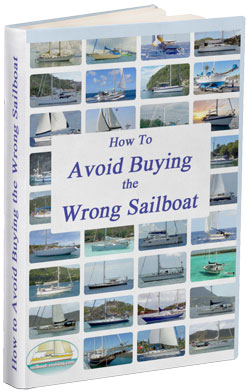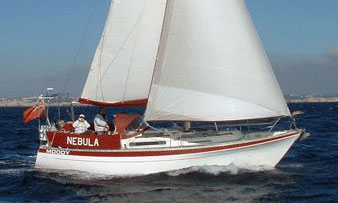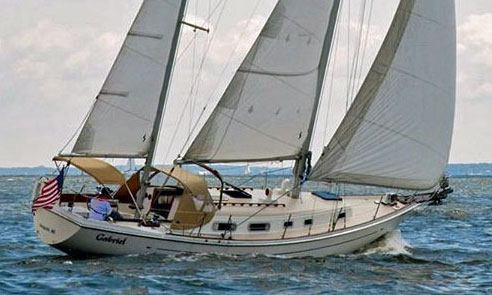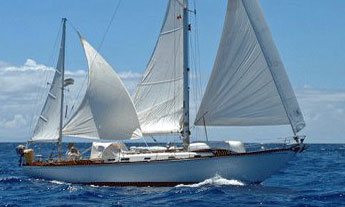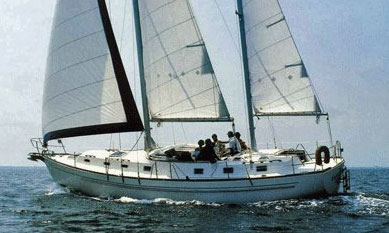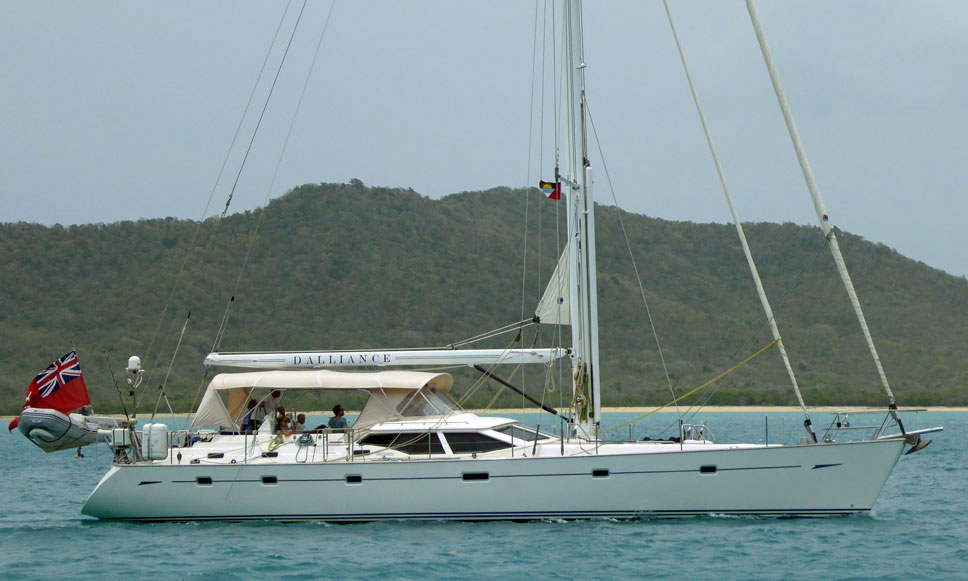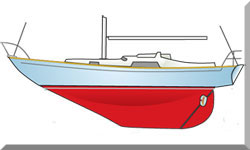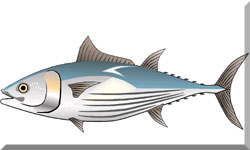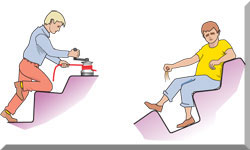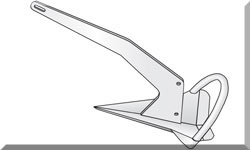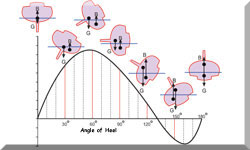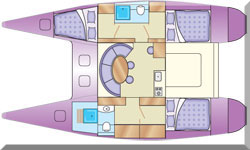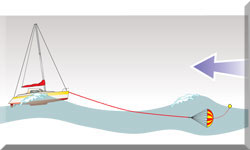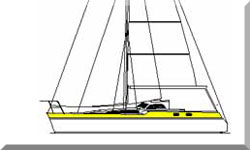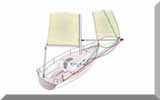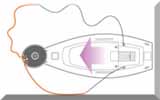- Home
- Cruising Yachts 40' to 45'
- Hinckley Bermuda 40
The Hinckley Bermuda 40 Sailboat
Specs & Key Performance Indicators
The Hinckley Bermuda 40 sailboat was designed by William H. Tripp Jr. and manufactured by Henry R. Hinckley & Co. (also known as Hinckley Yachts) in the United States throughout the years 1959 to 1991.
 Hinkley Bermuda 40
Hinkley Bermuda 40Published Specification for the Hinckley Bermuda 40
The specifications can vary slightly between the Mark I, Mark II, and Mark III versions. The following provides a general overview, noting variations where appropriate:
Keel & Rudder Configuration: Long keel with a bronze centreboard, operated via a worm gear, and a keel-mounted rudder controlled by a wheel. The centreboard is designed to kick up in a grounding.
Hull Material: Fibreglass. Early models had solid fibreglass decks; later Mark III boats used balsa-cored, then foam-cored decks that were vacuum-bagged.
Length Overall (LOA)*: 40'9" (12.42 m) for Mark I, II, and III.
Waterline Length (LWL)*:
- Mark I: 27'10" (8.48 m)
- Mark II & III: 28'10" (8.79 m or 8.8 m).
Beam*: 11'9" (3.58 m)
Draft*:
- Centreboard up (minimum): 4'3" (1.31 m) for Mark I and III; 4'6" (1.37 m) for Mark II.
- Centreboard down (maximum): 8'7" (2.62 m) for Mark I and III; 8'9" (2.67 m) for Mark II.
Rig Type: Masthead Yawl was standard, with a sloop rig offered as an option on later models (Mark III).
Displacement*:
- Mark I: 19,000 lb (8,618 kg).
- Mark II & III: 20,000 lb (9,072 kg).
Ballast*:
- Mark I: 6,500 lb (2,948 kg) of lead.
- Mark II: 7,000 lb (3,175 kg) of lead.
- Mark III: 6,500 lb (2,948 kg) or 7,000 lb for some sources (2,948 kg).
Sail Area (main plus 100% foretriangle)*:
- Mark I: 648.39 ft² (60.237 m²).
- Mark II: 657.03 ft² (61.040 m²).
- Mark III (Yawl): 776 ft² (72.1 m²).
- Mark III (Sloop): 725 ft² (67.4 m²).
- Some sources report 681 ft² (63.27 m²) for BERMUDA 40-3.
Water Tank Capacity: 110 US gallons (416.4 litres or 420 L; 92 imp gal).
Fuel Tank Capacity: 48 US gallons (181.7 litres or 180 L; 40 imp gal) or 50 gallons (189.3 litres).
Hull Speed:
- Mark I: 7.07 knots (13.1 km/h).
- Mark III: 7.19 knots (13.3 km/h) or 7.0 knots (13.0 km/h).
Designer: William H. Tripp Jr.
Builder: Henry R. Hinckley & Co. (Hinckley Yachts)
Year First Built: 1959.
Year Last Built: 1991.
Number Built: 203 of all variations.
* Used to derive the design ratios referred to later in this article - here's how they're calculated...
Options & Alternatives
Buyers of the Hinckley Bermuda 40 sailboat had several design options:
- Rig Type: All models were available as a masthead yawl or a masthead sloop.
- Deep or Shallow Draft: The Bermuda 40 featured a fixed long keel with a bronze centreboard, allowing for a variable draft. The "board up" (shallow) draft was approximately 4'3" (1.31 m) to 4'6" (1.37 m), while the "board down" (deep) draft ranged from 8'7" (2.62 m) to 8'9" (2.67 m). This design offered the advantage of both shoal draft for gunkholing and deeper draft for offshore performance.
- Interior Layouts: The standard interior layout provided sleeping accommodation for six people, with a double V-berth forward, and two straight settee berths in the main cabin around a drop-leaf dinette table, each with a pilot berth above. The galley was L-shaped on the port side, and a navigation station was opposite. A refrigerator was optional. Later Mark III boats sometimes featured alternative layouts, including dinette tables and dedicated navigation stations. A few examples also had double Pullman berths forward.
As previously mention, later versions of the Hinckley Bermuda 40 were produced, with essential differences from the original:
- Bermuda 40-1 (Mark I): Introduced in 1959. This was the original model with a displacement of 19,000 lb (8,618 kg) and 6,500 lb (2,948 kg) of ballast. Its total sail area was 648.39 ft² (60.237 m²).
- Bermuda 40-2 (Mark II): Introduced around 1968. This version replaced the flat plate centreboard with an airfoil-shaped centreboard and had a slightly raised mast height, resulting in approximately 20 ft² more sail area, bringing the total to 657.03 ft² (61.040 m²). It also had increased ballast (7,000 lb / 3,175 kg) and a higher waterline length of 28'10" (8.8 m). The displacement increased to 20,000 lb (9,072 kg).
- Bermuda 40-3 (Mark III): Introduced in 1971 or 1972 (in response to the IOR rule). This was the longest-lived model and incorporated more significant changes. The main mast was made over four feet taller and moved aft nearly two feet. This produced a higher-aspect ratio mainsail and a larger foretriangle for headsails, further increasing the sail area. More ballast (up to 7,000 lb or 6,500 lb depending on the source) was added to her external lead keel. It also featured hull and keel changes and a heavier centreboard. The Mark III was also offered with a sloop rig option in addition to the yawl.
Sail Areas & Rig Dimensions
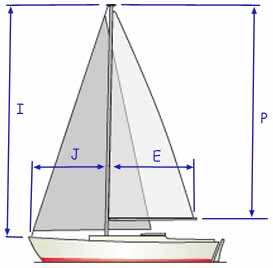 Sail Areas & Rig Dimensions
Sail Areas & Rig DimensionsSail Areas
The individual sail areas for the Hinckley Bermuda 40 (Mark I and Mark III variations are provided due to availability of data):
Mark I:
- Mainsail Area: 314.76 ft² (29.242 m²)
- Jib/Genoa Area (100% foretriangle): 333.63 ft² (30.995 m²)
Mark III (Yawl):
- Total Yawl Sail Area: 776 ft² (72.1 m²)
- Main Sail Area: 254.40 ft² (23.63 m²)
- Fore-triangle Area (100%): 426.30 ft² (39.60 m²)
Mark III (Sloop):
- Total Sloop Sail Area: 725 ft² (67.4 m²)
Rig Dimensions
The rig dimensions I, J, P, and E for the Hinckley Bermuda 40 also vary by Mark.
Mark I:
- I (foretriangle height): 42'6" (12.95 m)
- J (foretriangle base): 15'8" (4.79 m)
- P (mainsail luff): 36'7" (11.16 m)
- E (mainsail foot): 17'2" (5.24 m)
Mark III:
- I (foretriangle height): 49'0" (14.94 m)
- J (foretriangle base): 17'5" (5.30 m)
- P (mainsail luff): 42'5" (12.92 m)
- E (mainsail foot): 12'0" (3.66 m)
Published Design Ratios
The Key Performance Indicators (KPIs)
The published design ratios for the Hinckley Bermuda 40 also show some variation between Marks:
Mark I:
- Sail Area / Displacement (SA/D): 14.62 or 14.63.
- Ballast / Displacement (Bal./Displ.): 34.21%.
- Displacement / Length (Disp./Len.): 393.52.
- Comfort Ratio: 34.80.
- Capsize Screening Formula: 1.76.
Mark II:
- Sail Area / Displacement (SA/D): 14.32.
- Ballast / Displacement (Bal./Displ.): 35%.
- Displacement / Length (Disp./Len.): 372.60.
- Comfort Ratio: 35.84.
- Capsize Screening Formula: 1.73.
Mark III (Yawl):
- Sail Area / Displacement (SA/D): 16.82.
- Ballast / Displacement (Bal./Displ.): 32.50% or approximately 32.5%.
- Displacement / Length (Disp./Len.): 372.60 or 415.
- Comfort Ratio: 36.09 or 36.36.
- Capsize Screening Formula: 1.73.
Mark III (Sloop):Sail Area / Displacement (SA/D): 15.71.
Theoretical Sailing Characteristics
The design ratios provide a theoretical insight into a sailboat's performance and comfort characteristics. For the Hinckley Bermuda 40, primarily using Mark III data for consistency, these ratios suggest the following:
Sail Area / Displacement Ratio:
- Explanation: This ratio indicates how well-powered a vessel is by its sail area relative to its displacement. A higher SA/D generally means faster acceleration and better performance in light winds. Values around 15-18 are considered good for ocean cruising, while values below 12 might indicate an underpowered boat, and above 20 typically suggest a racing yacht.
- Bermuda 40 Characteristics: The Bermuda 40, with SA/D ratios generally in the mid-teens to upper-teens (especially the Mark III yawl), suggests it is a reasonably well-powered vessel. It should perform adequately in various conditions, leaning towards good performance in light to moderate air, particularly the Mark III due to its increased sail area. It is not designed as a pure racing yacht but has sufficient sail area for effective cruising.
Ballast / Displacement Ratio:
- Explanation: This ratio, expressed as a percentage, indicates how much of a yacht's total displacement is made up of ballast. It provides a guide to a yacht's initial stability or "stiffness"—its ability to resist heeling. A higher percentage generally indicates a stiffer, more stable boat. Around 35% is considered average, while 50% is very stiff, and 25% is regarded as tender.
- Bermuda 40 Characteristics: With a ballast ratio in the 32-35% range, the Hinckley Bermuda 40 is in the average to above-average range for stiffness for a cruising boat. This suggests it should have good initial stability and be able to stand up to the wind reasonably well, providing a secure and comfortable motion for offshore voyaging.
Displacement / Length Ratio:
- Explanation: This non-dimensional ratio expresses how heavy a boat is relative to its waterline length. It is an indicator of a boat's speed potential and its motion characteristics. Ultra-light displacement yachts have a D/L of less than 100, light is 100-200, moderate is 200-300, and heavy displacement is above 300. Heavy displacement boats tend to have a more comfortable ride in rough seas, as they go through waves rather than over them, and are generally less sensitive to overloading.
- Bermuda 40 Characteristics: With D/L ratios consistently above 370, the Hinckley Bermuda 40 is classified as a heavy displacement yacht. This indicates a robust, comfortable ride in a seaway, making it well-suited for offshore and long-distance cruising. It will be less prone to slamming in rough conditions but will generally be slower to accelerate and reach its hull speed compared to lighter displacement designs. Its performance will be less affected by adding cruising gear and stores.
Comfort Ratio:
- Explanation: The Comfort Ratio, developed by Ted Brewer, attempts to quantify a boat's comfort in a seaway. Higher numbers generally indicate a more comfortable motion, with numbers above 30 often considered comfortable for offshore passages.
- Bermuda 40 Characteristics: The Bermuda 40's Comfort Ratio consistently in the mid-30s confirms its reputation as a comfortable cruising yacht. This suggests a smoother motion in rough seas, aligning with the implications of its heavy displacement.
Capsize Screening Formula:
- Explanation: The Capsize Screening Formula is a simplified indicator of a boat's resistance to capsize in breaking seas. Lower numbers suggest better resistance to capsize. A CSF value of 2.0 or less is generally considered acceptable for offshore sailing.
- Bermuda 40 Characteristics: With a CSF consistently below 1.8, the Hinckley Bermuda 40 demonstrates good theoretical resistance to capsize, reinforcing its suitability for offshore and blue-water cruising.
In summary, the design ratios of the Hinckley Bermuda 40 collectively describe a traditional, heavily built, stable, and comfortable cruising sailboat, capable of handling challenging offshore conditions. It prioritises seakindliness and load-carrying ability over pure speed, although the Mark III variations show an increase in sail area for improved performance.
But the Design Ratios are Not the Whole Story...
While design ratios offer valuable insights, they have several limitations when used to define a sailboat's complete sailing characteristics:
Simplification of Complex Hydrodynamics and Aerodynamics: Ratios reduce complex interactions between the hull, keel, rudder, sails, wind, and waves into single numbers. They don't account for the intricate shapes of the hull and appendages (e.g., fin keel vs. full keel, bulb keel vs. long shoal draft keel), which significantly impact hydrodynamic drag and stability. Similarly, they don't fully capture the aerodynamic efficiency of different sail plans or how they interact with the rig and hull.
Reliance on Published (Light Ship) Displacement: Manufacturers often publish "light ship" or unladen displacement figures, which are the boat's weight without stores, liquids, or crew. In reality, a fully equipped cruising boat operates at a much higher "laden" displacement. Since displacement is a key parameter in most design ratios, using light displacement can lead to misleading results, particularly making a boat appear more powerful (higher SA/D) or lighter (lower D/L) than it truly is under cruising conditions.
Variability in Sail Area Calculation: The "sail area" used in the SA/D ratio can be ambiguous. Some manufacturers might use the actual sail area with a large overlapping genoa, while others stick to the 100% foretriangle and main. This inconsistency can make objective comparisons between different boats difficult if the basis of the calculation is not standardised (e.g., using I, J, P, E dimensions for a standardised calculation).
Ballast Placement and Hull Shape: The Ballast/Displacement ratio doesn't account for the location of the ballast. Ballast placed deep in a bulb keel provides more righting moment (stability) than the same amount of ballast spread along a shoal draft keel, even if the ballast ratio is the same. Similarly, hull shape, particularly beam and its distribution, significantly influences form stability, which is not fully captured by the ballast ratio alone.
Neglect of Real-World Factors: Design ratios don't consider critical factors such as:
- Wind and Sea State: Actual boat performance is heavily influenced by wind strength, angle, and sea conditions (waves, chop), which are dynamic and not reflected in static ratios.
- Hull and Rigging Windage: The drag created by the above-water portions of the hull and rigging.
- Crew Weight and Placement: The impact of crew weight and its distribution on trim and stability.
- Propeller Drag: The drag from a fixed or folded propeller.Foul Bottom: Growth on the hull can significantly increase drag.
- Build Quality and Finish: The quality of construction and the smoothness of the hull's wetted surface affect performance.
- Sail Condition and Trim: The efficiency of sails depends on their condition, cut, and how well they are trimmed for various points of sail.
"Don't take it as gospel": These ratios are indicators and tools for comparison between designs, not definitive predictors of an individual boat's performance or handling characteristics. A boat with "good" ratios could still be awkward to manoeuvre or poorly rigged in practice.
In conclusion, while design ratios provide a useful initial quantitative assessment for comparing sailboats and understanding general design philosophies, they are simplifications. For a complete understanding of a sailboat's characteristics and performance, one must consider a multitude of other design details, build quality, and real-world operational factors.
Sources & References
- The Hinckley Club: https://hinckleyclub.com/boats/bermuda-40-1/
- Practical Sailor - Hinckley Bermuda 40: https://www.practical-sailor.com/sailboat-reviews/hinckley-bermuda-40
- Hinckley's New Bermuda 50 Goes Sailing: https://www.hinckleyyachts.com/hinckleys-new-bermuda-50-goes-sailing/
- Wikipedia - Bermuda 40: https://en.wikipedia.org/wiki/Bermuda_40
- The Bermuda 40 Boat Review - SpinSheet: https://www.spinsheet.com/boat-reviews/bermuda-40-boat-review
- Wave Train - HINCKLEY BERMUDA 40: https://wavetrain.net/2010/09/24/hinckley-bermuda-40-everybodys-wet-dream-boat/
- Rustler Yachts - 3 useful formulas to help you choose a boat: https://www.rustleryachts.com/useful-formulas-to-help-you-choose-a-boat/
- Sail Magazine - Comparing Design Ratios: https://sailmagazine.com/boats/comparing-design-ratios/
- Ted Brewer Yacht Design - Comfort Ratio: https://www.tedbrewer.com/yachtdesign.html
- ResearchGate - Sailing Boat Performance Prediction: https://www.researchgate.net/publication/280896348_Sailing_Boat_Performance_Prediction
- Eric Sponberg - THE DESIGN RATIOS: https://www.ericwsponberg.com/wp-content/uploads/2021/09/THE-DESIGN-RATIOS.pdf
- Yachting Monthly - Understand your boat and her statistics: https://www.yachtingmonthly.com/yacht-reviews/understand-boat-statistics-30154
More Specs & Key Performance Indicators for Popular Cruising Boats
Recent Articles
-
Passoa 47 Sailboat Review: Comprehensive Specs & Performance Analysis
Jan 04, 26 04:57 AM
Discover the Passoa 47, a legendary aluminium blue water cruiser by Garcia. Explore technical specifications, design ratios, and why its lifting keel is a game-changer for offshore sailors. -
Sailboat Wheel Steering Maintenance & Inspection Checklist
Dec 30, 25 02:32 PM
Keep your vessel’s helm responsive and reliable with our expert maintenance checklist. Master cable tensioning and system inspections to avoid mid-passage failures. -
Modern Boat Electronics and the Latest Marine Instruments
Dec 20, 25 05:27 PM
Should sailboat instruments be linked to the latest boat electronics as a fully integrated system, or is it best to leave them as independent units?
